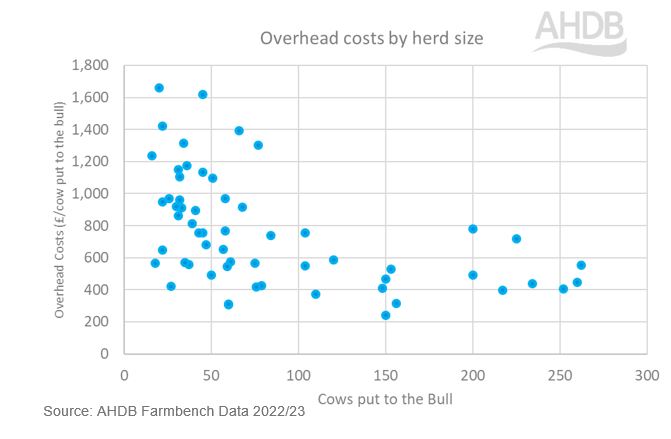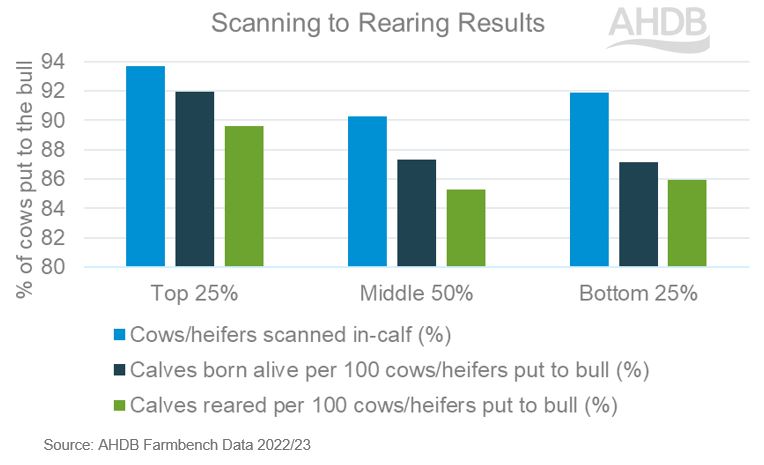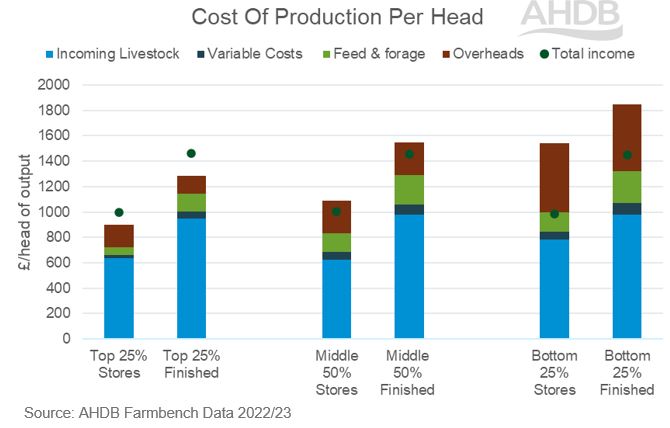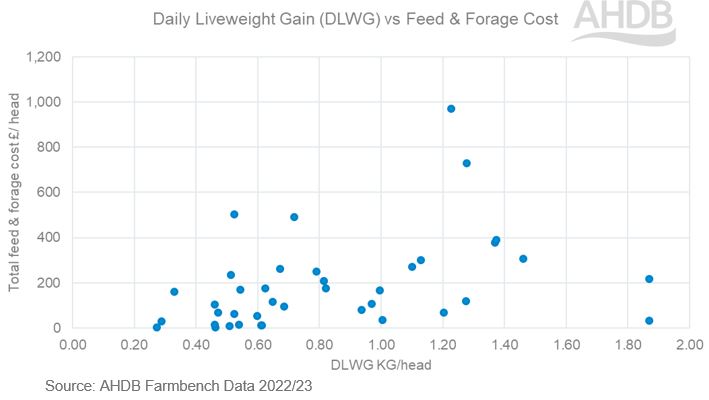Farmbench: Beef cost of production
Tuesday, 22 October 2024
Key points
- The top 25% of farms were consistently profitable across beef enterprises; however, the bottom 25% all made a loss
- Overhead control is key to profitability in cattle enterprises
- Year-on-year net profitability for suckler herds increased from 2021/22 to 2022/23 but varied across store and finishing enterprises
Suckler herds
Farmbench 2022/23 data shows that the top 25% of farms (ranked on net margin) tended to have both lower overheads and a larger average herd size. Overheads include labour, administration, machinery, property and energy. This suggests economies of scale are key to reducing cost of production, but this is not always the case.
Looking more closely, the data shows smaller herds achieving the same overheads per cow put to the bull. Overhead costs by herd size 2022/23 are presented below.
In addition to herd size, the top 25% were more prolific. Higher scanning and calving numbers alongside lower mortality levels in calves resulted in a higher number of calves at weaning and, subsequently, higher total incomes. Scanning to rearing results 2022/23 are presented below.
Store and finishing cattle
For store and finishing cattle, the variable costs such as vet med, bedding and total livestock incomes did not vary greatly from the top 25% to the bottom 25%. Some variation was seen between feed and forage costs; however, overhead costs within the middle 50% and bottom 25% were significantly higher. Cost of production per head for 2022/23 are presented below.
The top 25% of store and finishing enterprises saw net profits of £92.41/head and £172.68/head, respectively. The middle 50% achieved negligible profits of £6.94/head profit for stores and £0.18/head loss for finished cattle. Losses in the bottom 25% were greatest for store enterprises averaging a £308.50 loss per head, with finished cattle losing an average of £151.62/head.
Across the finishing enterprises, despite a 54% difference in feed spend between the top and bottom 25%, the data shows that higher feed and forage cost does not always equate to higher daily liveweight gains. DLWG vs feed and forage cost for 2022/23 are presented below.
Net margins year on year – 2021/22 to 2022/23
Net margins for suckler herds were improved in the 2022/23 year compared to 2021/22, with the top 25% of herds increasing their margin from £71.65 per cow put to the bull to £151.05. The middle 50% and bottom 25% still made losses despite the improved year. Profitability for the top 25% of finishing cattle enterprises was down 14% year on year from 35 pence per kilo to 30. For the middle 50% and bottom 25%, despite improved performance compared to last year, they still made losses.
The Farmbench tool is fully supported by AHDB through our Regional Farmbench Managers who can assist you in comparing your farm to the national dataset. Get in touch today to arrange a visit.
 - Zoe Kingham - 230913 PHOTO.jpg)
Sign up for regular updates
You can subscribe to receive Beef and Lamb market news straight to your inbox. Simply fill in your contact details on our online form.
While AHDB seeks to ensure that the information contained on this webpage is accurate at the time of publication, no warranty is given in respect of the information and data provided. You are responsible for how you use the information. To the maximum extent permitted by law, AHDB accepts no liability for loss, damage or injury howsoever caused or suffered (including that caused by negligence) directly or indirectly in relation to the information or data provided in this publication.
All intellectual property rights in the information and data on this webpage belong to or are licensed by AHDB. You are authorised to use such information for your internal business purposes only and you must not provide this information to any other third parties, including further publication of the information, or for commercial gain in any way whatsoever without the prior written permission of AHDB for each third party disclosure, publication or commercial arrangement. For more information, please see our Terms of Use and Privacy Notice or contact the Director of Corporate Affairs at info@ahdb.org.uk © Agriculture and Horticulture Development Board. All rights reserved.





